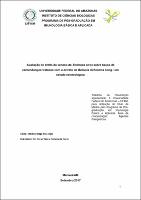| ???jsp.display-item.social.title??? |


|
Please use this identifier to cite or link to this item:
https://tede.ufam.edu.br/handle/tede/6244| ???metadata.dc.type???: | Tese |
| Title: | Teste de depósito |
| ???metadata.dc.creator???: | Anjos, Marissa Braga dos  |
| ???metadata.dc.contributor.advisor1???: | Costa, Oscar Tadeu Ferreira da |
| ???metadata.dc.description.resumo???: | O extrato aquoso da casca de Bellucia dichotoma (EaBd) é utilizado tradicionalmente em casos de acidentes ofídicos e tem se mostrado como promissor contra o envenenamento por Bothrops atrox (VBa). O soro antibotrópico (SAB) é a terapia convencional após o acidente com B. atrox. Há evidencias da ação bloqueadora local de EaBd em camundongos envenenados, contudo faltam estudos da ação sistêmica dessa planta contra VBa. A associação entre EaBd e SAB também poderia ser uma alternativa para o acidentado. O baço é o sítio responsável pela filtração, resposta imune do sangue, como também local da hematopoiese extramedular. No presente estudo, camundongos Swiss foram desafiados com o veneno botrópico e tratados com Bellucia dichotoma, utilizando a mesma concentração do extrato e condições de preparo da população nativa, a fim de investigar a ação do veneno e o possível efeito antiofídico do EaBd no período de 24 h. Assim, cinco tratamentos experimentais (n=4) foram estabelecidos: salina, (veneno de Bothrops atrox) VBa, VBa/EaBd, VBa/EaBd/SAB (soro antibotrópico) e VBa/SAB. Após o período experimental, os animais foram sacrificados e os baços removidos e fixados em formalina tamponada para posterior processamento em resina histológica. Cada órgão foi serialmente seccionado (9-12 seções/órgão) que permitiram a determinação do volume total do baço e de sua microestrutura segundo as modernas técnicas estereológicas. O veneno de B. atrox reduziu o volume da região eritropoiética da polpa vermelha e o volume da bainha linfoide periarteriolar (PALS), região rica em linfócitos T da polpa branca. Além disso, a população de macrófagos foliculares esteve significativamente aumentada no grupo VBa em relação aos demais grupos. O tratamento EaBd e EaBd/SAB não apresentaram alterações significativas, com exceção do componente cápsula que esteve aumentado em EaBd/SAB. Os tratamentos envolvendo o extrato também mostraram-se similares aos tratamentos salina e SAB. Em conclusão, o extrato aquoso de B. dichotoma administrado por via oral logo após o envenenamento por B. atrox é efetivo na inibição das alterações morfológicas quantitativas no baço de camundongos envenenado quando avaliados após 24 horas. |
| Abstract: | Aqueous extract from Bellucia dichotoma bark (EaBd) has traditionally been used in cases of snakes-bites accidents and has been shown to be promising against Bothrops atrox (VBa) poisoning. Antibothropic serum (SAB) is the conventional therapy after the accident with B. atrox. There is evidence of the local blocking action of EaBd in poisoned mice, however studies of the systemic action of this plant against VBa are lacking. The association between EaBd and SAB could also be an alternative for the injured. The spleen is the site responsible for filtration, immune response of the blood, as well as site of extramedullary hematopoiesis. In the present study, Swiss mice were challenged with bothropic venom and treated with Bellucia dichotoma, using the same extract concentration and native population preparation conditions, in order to investigate the action of venom and the possible antiofidic effect of EaBd in the period of 24 h. Thus, five experimental treatments (n = 4) were established: saline, VBa (Bothrops atrox venom), EaBd, EaBd/SAB and SAB. After the experimental period, the animals were sacrificed and the spleens removed and fixed in buffered formalin for further processing in histological resin. Each organ was serially sectioned (9-12 sections/organ) that allowed the determination of the total volume of the spleen and its microstructure according to modern stereological techniques. B. atrox venom reduced the volume of the erythropoietic region of the red pulp and the volume of the periarteriolar lymphoid sheath (PALS), a region rich in T lymphocytes of the white pulp. In addition, the population of follicular macrophages was significantly increased in the VBa group in relation to the other groups. The treatment EaBd and EaBd/SAB did not present significant changes, except for the capsule component that was increased in EaBd/SAB. The treatments involving the extract were also similar to saline and SAB treatments. In conclusion, the aqueous extract of B. dichotoma administered orally shortly after B. atrox poisoning is effective in inhibiting the quantitative morphological changes in the spleen of mice poisoned when evaluated after 24 hours. |
| Keywords: | Bothrops atrox Bellucia dichotoma Estereologia Histologia Baço Stereology Histology Spleen |
| ???metadata.dc.subject.cnpq???: | CIENCIAS BIOLÓGICAS: IMUNOLOGIA |
| Language: | por |
| ???metadata.dc.publisher.country???: | Brasil |
| Publisher: | Universidade Federal do Amazonas |
| ???metadata.dc.publisher.initials???: | UFAM |
| ???metadata.dc.publisher.department???: | Instituto de Ciências Biológicas |
| ???metadata.dc.publisher.program???: | Programa de Pós-graduação em Imunologia Básica e Aplicada |
| Citation: | ANJOS, Marissa Braga dos. Teste de depósito. 2017. 69 f. Tese (Doutorado em Imunologia Básica e Aplicada) - Universidade Federal do Amazonas, Manaus, 2017. |
| ???metadata.dc.rights???: | Acesso Aberto |
| URI: | http://tede.ufam.edu.br/handle/tede/6244 |
| Issue Date: | 29-Sep-2017 |
| Appears in Collections: | Doutorado em Agronomia Tropical |
Files in This Item:
| File | Description | Size | Format | |
|---|---|---|---|---|
| Dissertação_ Marissa B. Anjos.pdf | 1.4 MB | Adobe PDF |  Download/Open Preview |
Items in DSpace are protected by copyright, with all rights reserved, unless otherwise indicated.




